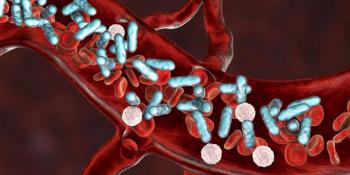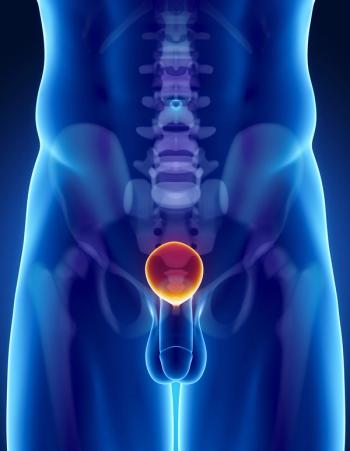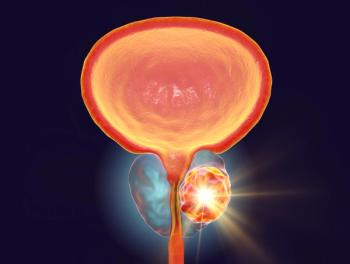
Durvalumab Combo Prolongs DFS in High-Risk BCG-Naive NMIBC
Data from POTOMAC support durvalumab plus BCG and induction and maintenance therapy as a new treatment option in BCG-naive, high-risk NMIBC.
Patients with Bacillus Calmette-Guérin (BCG)–naive, high-risk non–muscle-invasive bladder cancer (NMIBC) experienced a statistically significant and clinically meaningful disease-free survival (DFS) improvement in the phase 3 POTOMAC (NCT03528694) trial following treatment with durvalumab (Imfinzi) plus BCG induction and maintenance therapy, according to data presented at the
The findings were presented by Maria De Santis, MD, associate professor at the University of Warwick Medical School in Coventry, England, and simultaneously published in The Lancet.3The open-label, randomized study was made up of 1-018 patients who were randomized 1:1 in 3 cohorts: 339 received 1 year of durvalumab in combination with BCG induction and maintenance therapy, 339 received 1 year of durvalumab with BCG induction only, and 340 received only BCG and induction and maintenance therapy.2
The primary end point of DFS was achieved, with a 32% reduction in risk of a DFS event (HR 0.68; 95% CI, 0.50–0.93; P =.0154) with the addition of durvalumab to BCG induction and maintenance. Early and sustained DFS benefit with durvalumab was observed starting as early as 4 months (HR 0.68; 95% CI, 0.50-0.93; P =.0154). The median follow-up was 60.7 months.
However, the different in DFS for durvalumab plus BCG induction only vs BCG induction and maintenance was not statistically significant (HR, 1.14; 95% CI, 0.86–1.50; P =.3530).
While overall survival (OS) data were immature, there was no detriment to OS with the addition of durvalumab to BCG and induction and maintenance therapy (HR 0.80; 95% CI, 0.53–1.20).
The addition of durvalumab to BCG and induction and maintenance therapy had no major impact on patient-reported quality of life, one of the secondary end points of the trial.
Regarding safety, another key secondary end point, the results showed that the durvalumab/BCG regimen was tolerable and manageable with no unexpected toxicities, and there were no deaths possibly related to the study treatment reported. Grade 3 or 4 AEs possibly related to any treatment were reported in 21% of the durvalumab/BCG induction and maintenance arm, 15% of the durvalumab/BCG induction arm, and 4% of the BCG induction and maintenance arm.
The most frequently reported any-grade AEs in the durvalumab/BCG induction and maintenance and BCG-only arms included dysuria (37% vs 36%, respectively), hematuria (32% vs 30%), pollakiuria (26% vs 25%), urinary tract infection (21% vs 18%), cystitis (19% vs 19%), and pyrexia (16% vs 20%).
“Overall, these events were consistent with what we expected for durvalumab and BCG therapy with dysuria, hematuria, and pollakiuria being the 3 most commonly reported in both arms,” said De Santis during the presentation.2
Majority of the patients were male, and the median age was 68. Approximately 64% of patients had papillary disease only. Patients also had high-risk tumors, defined as being either T1, high grade, carcinoma in situ, or multiple and recurrent and large.2
Patients received a median of 6 BCG induction instillations and 14 BCG maintenance instillations, with a maximum of 15 in both arms. More than half of patients received BCG for 18 months.2
“In conclusion, POTOMAC supports 1 year of durvalumab with BCG and induction and maintenance therapy as a potential new treatment in BCG-naive, high-risk NMIBC,” De Santis said during the presentation.2
DISCLOSURES: De Santis declared a consulting or advisory role with AAA, Amgen, Astellas, AstraZeneca, Basilea, Bayer, Bioclin, Bristol Myers Squibb, Eisai, Ferring, Gilead Sciences, Immunomedics, Ipsen, Janssen, Merck Sharp & Dohme, Merck, Novartis, Pfizer, Roche, Sandoz, Sanofi, SeaGen, and Thermosome.
References
- Assessment of Efficacy and Safety of Durvalumab Plus BCG Compared to the Standard Therapy With BCG in Non-muscle Invasive Bladder Cancer (POTOMAC). ClinicalTrials.gov. Updated August 27, 2025. Accessed October 17, 2025. https://clinicaltrials.gov/study/NCT03528694
- De Santis M. Durvalumab (D) in Combination With Bacillus Calmette-Guerin (BCG) for BCG-Naive, High-Risk Non-Muscle-Invasive Bladder Cancer (NMIBC): Final Analysis of the Phase 3, Open-Label, Randomized POTOMAC Trial. Presented at: ESMO 2025 Congress; October 17-20, 2025; Berlin, Germany. Abstract LBA108.
- De Santis M, Redorta J, Nishiyama H, et al. Durvalumab in combination with BCG for BCG-naive, high-risk, non-muscle-invasive bladder cancer (POTOMAC): final analysis of a randomised, open-label, phase 3 trial. The Lancet. Published online ahead of print October 17, 2025. Doi: 10.1016/S0140-6736(25)01897-5
Newsletter
Stay up to date on recent advances in the multidisciplinary approach to cancer.


















































































